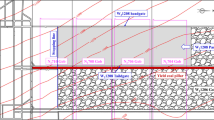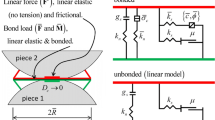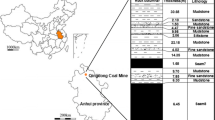Abstract
In this study, we systematically studied the occurrence regularity of in situ stress in the Pingdingshan mine. The critical criterion model of coal-rock destabilization was established based on the theoretical framework of fracture mechanics. Furthermore, we analyzed the coupling destabilization mechanism of in situ stress and gas and studied the influence of the variation between original rock stress and mining-induced stress on the critical criterion. Through field experiments and applications, we established a three-dimensional gas drainage technology system for areas with a large mining height and long work face. Based on our research, a demonstration project was developed for deep mine dynamic disaster control. The technical system included the arrangement and optimization of pre-drainage holes along the coal seam, technology, and optimization of gas drainage through the bottom drainage tunnel and upper corner, gas drainage technology through sieve tubes, and a two plugging with one injection under pressure sealing technology. The implementation of the demonstration project effectively reduced the gas content and pressure of the coal seam in the deep mine, and the project increased the critical strength of the instability and failure of coal and rock.
Similar content being viewed by others
References
ASTM (1983). Standard test method for plane strain fracture toughness of metallic materials. Annual Book of ASTM Standards, Part 10, Philadelphia: American Society for Testing and Materials
Cao H (2009). Research on fracture toughness of high-grade pipeline steel for gas and oil. Dissertation for Master’s Degree. Wuhan: Wuhan University of Technology
Deng H, Zhu M, Li J, Wang Y, Luo J, Yuan X (2012). Study of mode-I fracture toughness and its correlation with strength parameters of sandstone. Rock Soil Mech, 33(12): 71–77 (in Chinese)
Gong F, Lu D, Li X, Rao Q, Fu Z (2014). Toughness increasing or decreasing effect of hard rock fracture with pre-static loading under dynamic disturbance. Chinese J Rock Mech Eng, 33(9): 1905–1915 (in Chinese)
Kang H (2013). Stress distribution characteristics and strata control technology for roadways in deep coal mines. Coal Sci. Technol, 41(9): 12–17
Kuruppu M D, Obara Y, Ayatollahi M R, Chong K P, Funatsu T (2014). ISRM-suggested method for determining the mode I static fracture toughness using semi-circular bend specimen. Rock Mech Rock Eng, 47(1): 267–274
Li Y, Yang K, Qin R, Yu Y (2020). Technical system and prospect of safe and efficient mining of coal and gas outburst coal seams. Coal Sci Technol, 48(03): 167–173
Liu X, Liu Q, Liu B, He J (2018). Research on numerical method for crack propagation simulation with consideration of damage effect. Chinese J Rock Mech Eng, 37(S2): 64–72
Liu Y, Lebedev M, Zhang Y, Wang E, Li W, Liang J, Feng R, Ma R (2022). Micro-cleat and permeability evolution of anisotropic coal during directional CO2 flooding: an in situ micro-CT study. Nat Resour Res, 31(5): 2805–2818
Lu Y (2018). Effect of bedding plane direction on fracture toughness of shale under different loading rates. Chinese J Rock Mech Eng, 37(6): 1359–1370 (in Chinese)
Ma L, Cao H, Zhang Z, Gao Q, Luo Z (2019). An experimental investigation of the fracture behaviors of type-I cracks in shales with different bedding angles. Petrol Sci Bull, 4(04): 347–353 (in Chinese)
Qi Q, Pan Y, Shu L, Li H, Jiang D, Zhao S, Zou Y, Pan J, Wang K, Li H (2018). Theory and technical framework of prevention and control with different sources in multi-scales for coal and rock dynamic disasters in deep mining of coal mines. J China Coal Soc, 43(07): 1801–1810 (in Chinese)
Srawley J E, Brown W F (1965). Fracture toughness testing methods. ASTM Spec Tech Publ, 381: 133–145
Tian J, Wang L, Cheng Y, Ma X, Li W, Shen Z (2008). Research on distribution rule and forecast method of gas pressure in coal seam. J Min Safety Eng, 25(4): 481–485 (in Chinese)
Whittaker B N, Singh R N, Sun G (1992). Rock Fracture Mechanics: Principles, Design and Applications. Amsterdam: Elsevier
Xie H, Gao F, Ju Y, Gao M, Zhang R, Gao Y, Liu J, Xie L (2015). Quantitative definition and investigation of deep mining. J China Coal Soc, 40(01): 1–10 (in Chinese)
Yan B (2010). Experimental study on reasonable parameters of gas pre-drainage in coal seam. Energy Tech Manag, 5: 32–34 (in Chinese)
Zhang B, Yang S, Kang L, Zhai Y (2008). Discussion on method for determining reasonable position of roadway for ultra-close multi-seam. Chinese J Rock Mech Eng, 1: 97–101 (in Chinese)
Zhang J G (2015). Geostress measurement technology by rheological stress recovery method and its application. Safety in Coal Mines, 46(S1): 34–38 (in Chinese)
Zhang J G, Lan T W, Wang M, Gao M Z, Rong H (2019). Prediction method of deep mining dynamic disasters and its application in Pingdingshan mining area. J China Coal Soc, 44(6): 1698–1706 (in Chinese)
Zhang J, Song Z (2020). Mechanical response and failure characteristics of deep sandstone under triaxial loading and unloading. J Min Safety Eng, 37(2): 409–418+428
Zhang Z X, Kou S Q, Lindqvist P A, Yu Y (1998). The relationship between the fracture toughness and tensile strength of rock. In: Strength Theories: Applications, Evelopment & Prospects for 21st Century. Beijing/NewYork: Science Press
Zhu L, Li Z, Liu H (2017). Consequential mechanism and the monitoring technique for the gassy coal-rock dynamics disaster in the deep mining. J Safety Environ, 17(03): 937–942 (in Chinese)
Acknowledgments
This study was financially supported by the National Natural Science Foundation of China (Grant No. 51874053), the Scientific Research Foundation of State Key Laboratory of Coal Mine Disaster Dynamics and Control (No. 2011DA105287-zd201804).
Author information
Authors and Affiliations
Corresponding author
Rights and permissions
About this article
Cite this article
Zhang, J., Wang, M., Zhou, H. et al. Coal and rock dynamic disaster prevention and control technology in the large mining face of a deep outburst mine. Front. Earth Sci. 17, 701–712 (2023). https://doi.org/10.1007/s11707-022-1060-8
Received:
Accepted:
Published:
Issue Date:
DOI: https://doi.org/10.1007/s11707-022-1060-8




